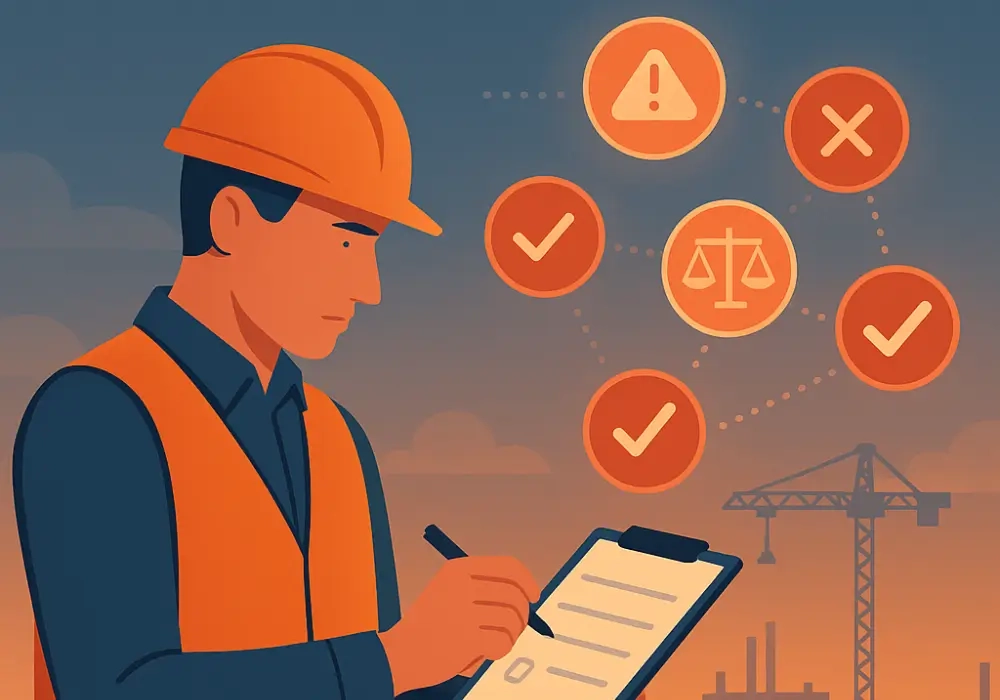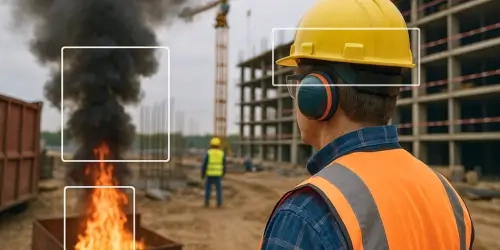Keeping compliant is no longer a choice for construction firms, but rather an essential in order to protect their business, employees and the general public.
However, with such strict regulations, many construction sites still fall victim to common compliance failures and these can lead to catastrophic consequences.
We explore the true cost of non-compliance, common failures and lessons to be learnt from these.
The Cost of Getting Compliance Wrong in Construction
With fines ranging from thousands to millions, compliance can be costly within construction.
Due to the high risks surrounding environmental impacts, health and safety and data privacy, regulations constantly change to manage the vulnerabilities presented to the industry.
From HSE alone, they completed 248 prosecutions relating to health and safety in 2023/24, rising from 216 in 2022/23. This shows an emphasis in holding construction firms accountable for compliance, and in turn facing legal and financial consequences of this.
However, the cost of getting compliance wrong extends much further than just the financial impacts:
-
Reputational damage caused by lost trust from clients, regulators and investors, creating an inability to gain contracts and tenders in the future.
-
Operational disruption caused by project delays, site shutdowns and revoked work permits whilst investigations occur or as correction action takes place.
-
Loss of employee morale and retention due to increased stress and loss of trust in the company, leading to higher turnover relating to compliance-based incidents.
-
Regulatory pressures caused through heightened inspections, tighter oversight and stricter reporting obligations from enforcement bodies like HSE and ICO.
-
Legal liability which can lead to personal accountability of leadership like compliance officers and directors. Consequences can vary from disqualification to criminal charges.
-
Insurance implications caused by higher premiums or the withdrawal of coverage due to the perceived increase of risk exposure at a construction site.
-
Evidence gaps due to a lack of reliable documentation and reporting, creating difficulties with audits and defending against any insurance claims.
-
Poor work culture as compliance continues to be seen as ‘red tape’ and even worsening effects that lead to employees becoming disengaged and less likely to adhere to compliance standards.
For compliance leaders juggling these dangers on a daily basis, they and their teams face heavy pressures to maintain compliance regulations for the sake of the firm and themselves.
The Hidden Pressures on Compliance Managers
With rising regulatory complexities, from HSE and GDPR to ESG and environmental controls, there’s growing pressures for compliance managers to ensure their firms avoid failures that could interrupt operations.
On top of this, compliance teams often face limited resources, meaning managers are left with more responsibilities and less availability within their team to cover this.
And with regulations changing on a regular basis, personal accountability has increased and this adds pressure onto managers who are often those most responsible for preventing non-compliance.
Otherwise, they risk facing legal action and financial penalties that directly impact themselves and their team.
Combining all the challenges compliance managers are faced with, all creates personal stress, lowered morale and lowered wellbeing. This can escalate into employees leaving, creating high turnover and creating difficulties on teams already stretched with both budgets and responsibilities.
The Most Common Compliance Failures on Construction Sites
It only takes one compliance failure to cause a large financial penalty, or even a site shutdown.
The last thing any compliance manager will want is for the construction firm to fall victim to a common compliance failure that could have been avoided.
Placing risks to projects and people, for any compliance manager, they should be aware of the common failures on construction sites. This helps to establish the best response, helping teams to remain proactive rather than reactive.
We’ve detailed a list of the common compliance failures facing construction sites, and the risks they come with:
Poor Site Safety and Inadequate PPE Usage
Lapses in site safety often occur when construction workers fail to follow compulsory PPE requirements or when safety inspections are irregular leading to inaccurate or poor documentation of on-site safety.
For example, builders not having hard hats and high-vis vests correctly when on site.
This increases the following risks:
-
Increased risk of injury or fatalities on-site.
-
Fines and legal liabilities relating to health and safety regulation breaches.
-
Reputational damage to the construction firm.
-
Potential work stoppages or revoked permits due to regulatory intervention.
Manual and Inconsistent Reporting
Most construction firms still rely upon manual reporting. Often spreadsheet-based, data tends to become fragmented and cause delays, which creates complexities around keeping compliance evidence consistent across the company.
This leads to evidence gaps and inaccuracies in documentation, leading to further difficulties with audits.
This increases the following risks:
-
Missed compliance deadlines and insufficient audit trails for regulators.
-
Poor decision-making due to unreliable and inconsistent data.
-
Regulatory penalties and/or legal action for failing to meet or maintain standards for accurate compliance records.
Lack of Real-Time Visibility Across Sites
Without real-time monitoring provided through a centralised system of all compliance activities, it’s extremely difficult to detect breaches or threats early.
Fragmented systems and poor monitoring creates limited visibility that undermines governance, which is a part of ESG standards. In turn, this reduces trust and confidence in audit readiness, and increases the likelihood of undetected non-compliance or security breaches.
This increases the following risks:
-
Slow incident response times to security breaches and non-compliance events.
-
Limited accountability and site overview.
-
Quick escalations of minor safety or compliance incidents into major violations.
-
Regulatory fines due to undetected compliance or security breaches.
Speak to us About Our Real-Time Monitoring System
Insufficient Documentation and Record-Keeping
Missed inspection logs, lack of footage following a compliance incident, or incomplete audit trails are all common compliance weaknesses.
In heavily regulated industries like construction, insufficient documentation and record-keeping compromises a firm’s ability to demonstrate due diligence, leading to severe reputational damage, failed audits and substantial fines.
This increases the following risks:
-
Audit failures and non-compliance with industry regulations.
-
Financial penalties, legal action and potential loss of site operating licences.
-
Reduced protection against insurance and legal claims.
Neglecting Environmental and Waste Management Rules
Waste management has become vital in construction, with it being one of the biggest contributors to greenhouse gas emissions and due to their large waste production.
Failing to properly track waste disposal or environmental impact of construction sites breaches ESG and HSE obligations set out within the industry.
This increases the following risks:
-
Heavy fines and environmental sanctions.
-
Significant reputational damage to the firm from public and media scrutiny.
-
Long-term environmental damage and remediation costs.
-
Disrupts sustainability targets for the business.
Weak Management of Contractors and Third Parties
Many compliance gaps stem from poor site management of contractors and third-party visitors or companies. Limited visibility, insufficient verification, and poor compliance reporting, all contribute to a heightened risk profile.
Third-party failures become your construction firm’s responsibility, placing both operational integrity and governance assurance into questions for clients, regulators and investors.
This increases the following risks:
-
Intrusions on-site, leading to crime like metal theft and vandalism.
-
Exposure to legal action based on third-party non-compliance.
-
Inconsistent safety standards across construction sites.
-
Heightened risk of safety incidents and project delays.
Lack of Employee Training and Supervision
Employees play a key role in maintaining compliance at construction sites, so any inconsistencies in training or poor reinforcement of this, increases the risk of documentation failures and safety breaches.
Compliance that appears as ‘red tape’ to employees risks creating a negative outlook from employees and is likely to lead to disengagement in maintaining regulations on-site.
This increases the following risks:
-
Higher accident rates due to poor training and human error.
-
Industry and legal breaches for not meeting or maintaining legal requirements.
-
Reduced productivity and poor morale leading to higher turnover.

Lessons to Learn From: How to Strengthen Construction Compliance
In tightly regulated sectors like construction, compliance failures commonly form from fragmented systems, manual reporting, and improper safety practices.
For compliance managers, every lapse represents a potential security breach and liability claim which results in legal, financial and reputational damage.
However, from every compliance failure, there is something to be learnt from. By establishing the root causes behind common lapses like the ones mentioned above, you can decide the best steps to take in order to strengthen your construction sites’ safety and security and reduce regulatory risks.
The following table outlines key lessons to be learnt from the common compliance failures, and subsequent actions that your construction firm can take to build a more resilient compliance framework.
| Compliance Failure | Lesson to be Learned | Recommended Actions and Tools |
| Poor Site Safety and Inadequate PPE Usage | Ensure consistent enforcement, regular monitoring, and accountability across your sites through building a proactive safety culture. | Install PPE detection systems and CCTV cameras (ideally integrated) to automate alerts if any safety breaches occur. This helps to maintain compliance with HSE safety standards. |
| Manual and Inconsistent Reporting | Automate compliance reporting to ensure accurate and reliable audit trails, without the need for slow manual reporting. | Implement one centralised platform that offers a compliance dashboard that integrates CCTV footage, reporting and incident logs in one. |
| Lack of Real-Time Visibility Across Sites | Improve site visibility through integrated monitoring to enable early threat detection and fast incident response. | Deploy real-time surveillance and safety monitoring backed by AI-driven technology with remote access for site managers and regulators. |
| Insufficient Documentation and Record-Keeping | Maintain clear, audit-ready digital records to demonstrate due diligence to regulators and avoid penalties. | Utilise a secure, cloud platform that collects audit trails, automated documentation, and incident reports all-in-one. |
| Neglecting Environmental and Waste Management Rules | Embed ESG commitments and environmental controls into everyday routine to ensure compliance throughout site operations. | Integrate environmental monitoring tools (air quality, weather, noise monitoring) and waste tracking to meet ESG requirements. |
| Weak Management of Contractors and Third Parties | Strengthen your third-party and contractor management through access control, increased oversight, and employee training. | Introduce intrusion detection systems, ANPR and CCTV cameras to monitor suppliers and visitors, whilst tracking any suspicious behaviour. |
| Lack of Employee Training and Supervision | Establish continuous compliance training, from onboarding to refresher training. | Adopt e-learning platforms where you can track progress and completion, and ensure all employees maintain up-to-date with training, especially if there’s been changes. |
In order to turn compliance from being seen as red tape into a strategic enabler across your construction sites, requires you to do more than just meet minimum regulatory standards.
It demands audit-ready reporting, proactive prevention, complete site overview and a strong culture of accountability.
AI-driven technology and unified platforms help offer automated monitoring, streamlined reporting and strong employee culture that drives compliance throughout the business.
However, with many security companies now promoting AI within their offering, it’s essential for your construction firm to partner with a well-established security company driven to provide innovation.
How WCCTV is Turning Your Site From Risk to Reliance
With over 20-years of security expertise across a wealth of industries, WCCTV understands the importance of selecting the right provider for your construction sites.
Our market-leading CCTV Towers and Redeployable CCTV Cameras offer complete flexibility in both relocatability and rental period, without minimising the quality of service.
However, most importantly, our offering goes beyond security through the support of our in-house platform, Stellifii. When backing our systems, it transforms compliance from ‘red tape’ into data-driven advantage.
Offering automated monitoring, audit-ready reporting, and secure evidence capture, it removes the time-consuming process of manual reporting for compliance leaders, enabling them to maintain full oversight across all sites.
Through our market-leading CCTV solutions and all-in-one intelligence system, Stellifii, we can integrate safety, environmental, and safety management within one secure system, minimising the need for multiple suppliers, improving cost efficiency and streamlining compliance now and for the future.
See how intelligent monitoring can make compliance effortless and auditable across every sites today by getting in touch with one of our Stellifii experts.



